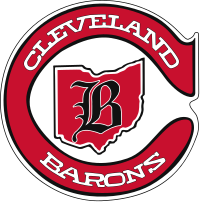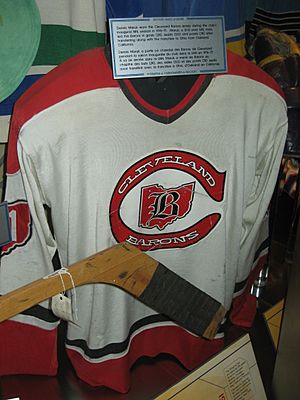Cleveland Barons (NHL) facts for kids
Quick facts for kids Cleveland Barons |
|
|---|---|
 |
|
| Founded | 1967 |
| History | California Seals 1967 Oakland Seals 1967–1970 Bay Area Seals (briefly) / California Golden Seals 1970–1976 Cleveland Barons 1976–1978 Minnesota North Stars merger June 14, 1978 |
| Home arena | Richfield Coliseum |
| City | Richfield, Ohio |
| Colors | Red, black, white |
The Cleveland Barons was a professional ice hockey team in the National Hockey League (NHL) from 1976 to 1978. They were a relocation of the California Golden Seals franchise that had played in Oakland since 1967. After just two seasons, the team merged with the Minnesota North Stars (now the Dallas Stars). As a result, the NHL operated with 17 teams during the 1978–79 season.
As of 2024, the Barons remain the last franchise in the four major North American sports leagues to cease operations. Ohio did not have another NHL team until the Columbus Blue Jackets joined the league 22 years later in 2000.
Contents
History

The Barons originated as the California Golden Seals in the 1967 NHL expansion. After new arena plans in San Francisco were cancelled, the NHL dropped its objection to a relocation of the perpetually troubled franchise from Oakland. Minority owner George Gund III persuaded majority owner Melvin Swig to move the team to his hometown of Cleveland for the 1976–77 season. The team was named "Barons" in honor of the successful team in the American Hockey League (AHL) that played in the city from 1929 to 1973, winning nine Calder Cups. The AHL Barons' owner, Nick Mileti, moved that team to Florida in favor of his Cleveland Crusaders team in the new World Hockey Association (WHA).
Cleveland had been mentioned as a possible NHL city as early as the 1930s, when the then-struggling Montreal Canadiens considered moving there. It had also been turned down for an NHL expansion team on three previous occasions, in the 1950s and 1960s.
The Barons played in the suburban Richfield Coliseum in Richfield, Ohio, an arena originally built for the WHA's Crusaders (who left to become the second incarnation of the Minnesota Fighting Saints for the 1976–77 WHA season on the Barons' arrival) and the NBA's Cleveland Cavaliers. At the time, the Richfield Coliseum had the largest seating capacity in the NHL, at 18,544.
The NHL approved the move to Cleveland on July 14, 1976, but details were not finalized until late August, and there was little time or money for promotion of the new team. The Barons never recovered from this lack of visibility. They never came close to filling the Coliseum in their two years in Cleveland. The team's home opener on October 7, 1976, drew only 8,900 fans. They drew 10,000 or more fans in only seven out of 40 home games. Attendance was worse than it had been in Oakland and the team did not even draw as many fans as the WHA's Crusaders had. The Barons were also troubled by an unfavorable lease with the Coliseum.
In January 1977, Swig hinted the team might not finish the season because of payroll difficulties. He asked the board of governors for a bailout. The board turned down Swig's request almost out of hand. At the time, no one in the NHL offices believed that the Barons' situation was nearly as dire as Swig claimed. No NHL team had folded since the Montreal Maroons had their franchise formally canceled in 1947 after not icing a team since 1938. No team had folded in mid-season since the Montreal Wanderers disbanded during the NHL's inaugural season in 1917–18 after their arena burned down. The situation quickly deteriorated and team workers went unpaid for two months. The bottom fell out in February, when the team missed two payrolls. The league seriously considered folding the team and holding a dispersal draft for the players; by then, some of the Barons' players were actively being courted by other teams. By February 18, the players had lost their patience, and threatened to not take the ice for their game against the Colorado Rockies. Wanting to avoid the embarrassment of a player strike, as well as a team folding at mid-season (the latter had previously happened in the rival WHA), the league and the NHLPA made a last-minute $1.3 million loan to allow the Barons to finish the season. After the team finished last in the Adams Division again, Swig sold his interest to Gund and his brother Gordon.
For 1977–78, the Gunds poured money into the team, and it seemed to make a difference at first. The Barons stunned the defending Stanley Cup champion Montreal Canadiens on November 23 before a boisterous crowd of 12,859. After a brief slump, general manager Harry Howell pulled off several trades in an attempt to make the team tougher. It initially paid off, and the Barons knocked off three of the NHL's top teams, the Toronto Maple Leafs, New York Islanders and Buffalo Sabres in consecutive games in January 1978. A few weeks later, a record crowd of 13,110 saw the Barons tie the Philadelphia Flyers 2–2. It did not last; a 1-13-8 streak knocked the Barons out of playoff contention.
Merger and aftermath
After the season, the Gunds tried to buy the Coliseum, but failed. (They would later succeed in buying the Coliseum, and eventually bought the Cavaliers from Ted Stepien in 1983). With the Barons barely registering on Cleveland's sports landscape, the Gunds searched for a way out. A bid by Kenneth Schnitzer, owner of the WHA's Houston Aeros (who were not being included as part of any proposed merger between the two leagues at the time) to buy the Barons and relocate them to Houston was unsuccessful.
Meanwhile, the consortium that owned the Minnesota North Stars was having its own financial difficulties similar to those faced by the Barons. Fearing that two franchises were on the verge of folding, the league granted approval on June 14, 1978, for the two teams to merge. The amalgamated team retained the North Stars' name, colors, and history, while the wealthier Gunds became the principal owners of the North Stars.
The NHL finally agreed to absorb the WHA one year later, a development which resulted in a two decade absence of major league hockey in Ohio since the WHA's Cincinnati Stingers were not included in the merger. However, the NHL worked to keep interest in hockey alive in the state. The Pittsburgh Penguins, who from 1978 to 1991 were owned by Northeast Ohio native Edward J. DeBartolo, Sr., played two designated home games at the Richfield Coliseum in the early 1990s before the arena was demolished and the land added to Cuyahoga Valley National Park. The NHL finally returned to Ohio in 2000 with the expansion Columbus Blue Jackets.
Dennis Maruk was the last Baron (and last Golden Seal as well) to be active in the NHL, retiring from the North Stars after the 1988–89 season with 356 goals in 888 games.
With the North Stars continuing to struggle financially, the Gunds began looking to bring NHL hockey back to the Bay Area. By the late 1980s, they sought to relocate the North Stars but were blocked by the league. In 1991, the Gunds were granted an expansion franchise in San Jose, which became the San Jose Sharks, in return for selling their stake in the North Stars to a group led by Hartford Whalers' founder Howard Baldwin. As a compromise, the league arranged a special dispersal and expansion draft in which the Sharks claimed 16 North Stars players in a dispersal draft, with both teams then allowed to choose players in an expansion draft.
Although the Sharks are officially a separate franchise from the Seals/Golden Seals/Barons, the arrangement effectively reversed the original Barons-North Stars merger, with the Sharks occupying the same market as the Golden Seals prior to their move to Cleveland. The new North Stars owners ultimately moved their team to Dallas as the Dallas Stars in 1993. The Gunds also later moved an existing American Hockey League team from Lexington, Kentucky, to Cleveland, operating the Cleveland Barons from 2001 to 2006 as the Sharks' minor league affiliate.
Season-by-season record
Note: GP = Games played, W = Wins, L = Losses, T = Ties, Pts = Points, GF = Goals for, GA = Goals against, PIM = Penalties in minutes
| Season | Team | GP | W | L | T | Pts | GF | GA | PIM | Finish | Playoffs | Avg. attendance |
| Relocated from Oakland, California | ||||||||||||
| 1976–77 | 1976–77 | 80 | 25 | 42 | 13 | 63 | 240 | 292 | 1011 | 4th in Adams | Missed playoffs | 6,194 |
| 1977–78 | 1977–78 | 80 | 22 | 45 | 13 | 57 | 230 | 325 | 1010 | 4th in Adams | Missed playoffs | 5,676 |
| Merged with the Minnesota North Stars | ||||||||||||
| Totals | — | 160 | 47 | 87 | 26 | 120 | 470 | 617 | 2021 | |||
Broadcasters
In their two years in Cleveland, Larry Hirsch served as the Barons' radio play-by-play announcer on WJW. On the television side, WUAB channel 43 did a very limited schedule with Steve Albert and Dick Hammer on commentary in 1976–77, and perhaps only one game in 1977–78 with Charlie Steiner and Pete Franklin on commentary.
Notable players
Team captains
- Jim Neilson and Bob Stewart, 1976–1978 (co-captains)
First round draft picks
- 1976: Bjorn Johansson (fifth overall) selection made by California Golden Seals as the move to Cleveland had not yet taken place
- 1977: Mike Crombeen (fifth overall)
Head coach
- Jack Evans, 1976–1978
General managers
- Bill McCreary, 1976–1977
- Harry Howell, 1977–1978
See also
 In Spanish: Cleveland Barons para niños
In Spanish: Cleveland Barons para niños
- List of Cleveland Barons players
- List of Cleveland Barons draft picks
- List of NHL seasons

